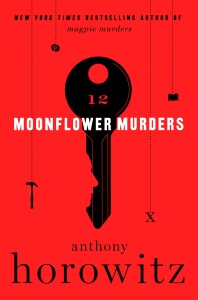 Anthony Horowitz’s Moonflower Murders is the second book in the Susan Ryeland series, and like its predecessor it is a nested mystery with two novels within the covers. One is the mystery Susan is solving, and the other a book by the fictitious and posthumous Alan Conway, following his detective Atticus Pünd. It is an unusual approach for a mystery novel, but impressive for the eccentricity.
Anthony Horowitz’s Moonflower Murders is the second book in the Susan Ryeland series, and like its predecessor it is a nested mystery with two novels within the covers. One is the mystery Susan is solving, and the other a book by the fictitious and posthumous Alan Conway, following his detective Atticus Pünd. It is an unusual approach for a mystery novel, but impressive for the eccentricity.
Layer upon layer of parallels are given to the reader, with Susan owning and operating a hotel even as murders are commited and solved regarding two hotels in the past, one in Suffolk and the other inside a novel in Devon. Susan has severe,money problems with her hotel, as does the victim in the Atticus Pund mystery. These parallels are an interesting choice for Horowitz to make, as they involve making an in-universe fiction book parallel a much later situation for what is allegedly a real woman in Susan.
The decision to have Susan and others frequently insult the Atticus Pünd novels is interesting, in no small part because the reader spends over two hundred continuous pages reading the insulted material. On the otger hand the aforementioned books are bestsellers, and compared to the much veloved Agatha Christie. Given the peculiarities of Pünd, and his differential politeness, a reader may indeed find themselves accidentally giving him a Belgian accent in their head.
Many characters from the first book return, and the something do a jerk author plays a key role despite passing on in a previous volume. This seems more natural than most readers might expect, as while many would not stay closely in the life Susan had built since the last book, the new incident connected to an Atticus Pünd novel would naturally draw in others related to the works. It might draw upon some coincidence, but any series featuring a detective outside of the profession must be given a certain amount of leeway in that regard.
It is interesting that Horowitz created a nested mystery series line this. While either of the basic narratives might have sold well in their own, the combination creates something unusual. It also, undoubtedly, increases the effort significantly. Multiple clues have to be placed in the novel within, so that Susan can find them as she reads the book, and the reader knows that they were present as well. The revisions to either text would require, due to this arrangement, thorough examinations of both sets of work.
This volume is an excellent example of the import format can have when reading a book. The within volume, officially titled Atticus Pünd Takes the Case, has completely diffwrent formatting from the pages of Moonflower Murders. Not only are the page numbers moved, but the headings, arrabgements of pages, and manner of chapter decision serve starkly different purposes as well. Indeed a cover and page filled with minor publication details are even among the information included, with details virtually no one reads meticulously reporduced. While some of these details can be reproduced in an ebook, popular ebook formats would render much of the work in a less impressive manner, likely losing the bulk of the small differences in the process.
Moonflower Murders is an excellent, albiet long, volume. Even the length is served well, with a short novel wedged inside of the longer, and a set of entertaining characters. The setting is easy to understand, and the baggage from the previous volume does not overweon the narrative. This is easy to recommend to those who enjoyed the first book, as well as new readers.
(Harper, 2020)
